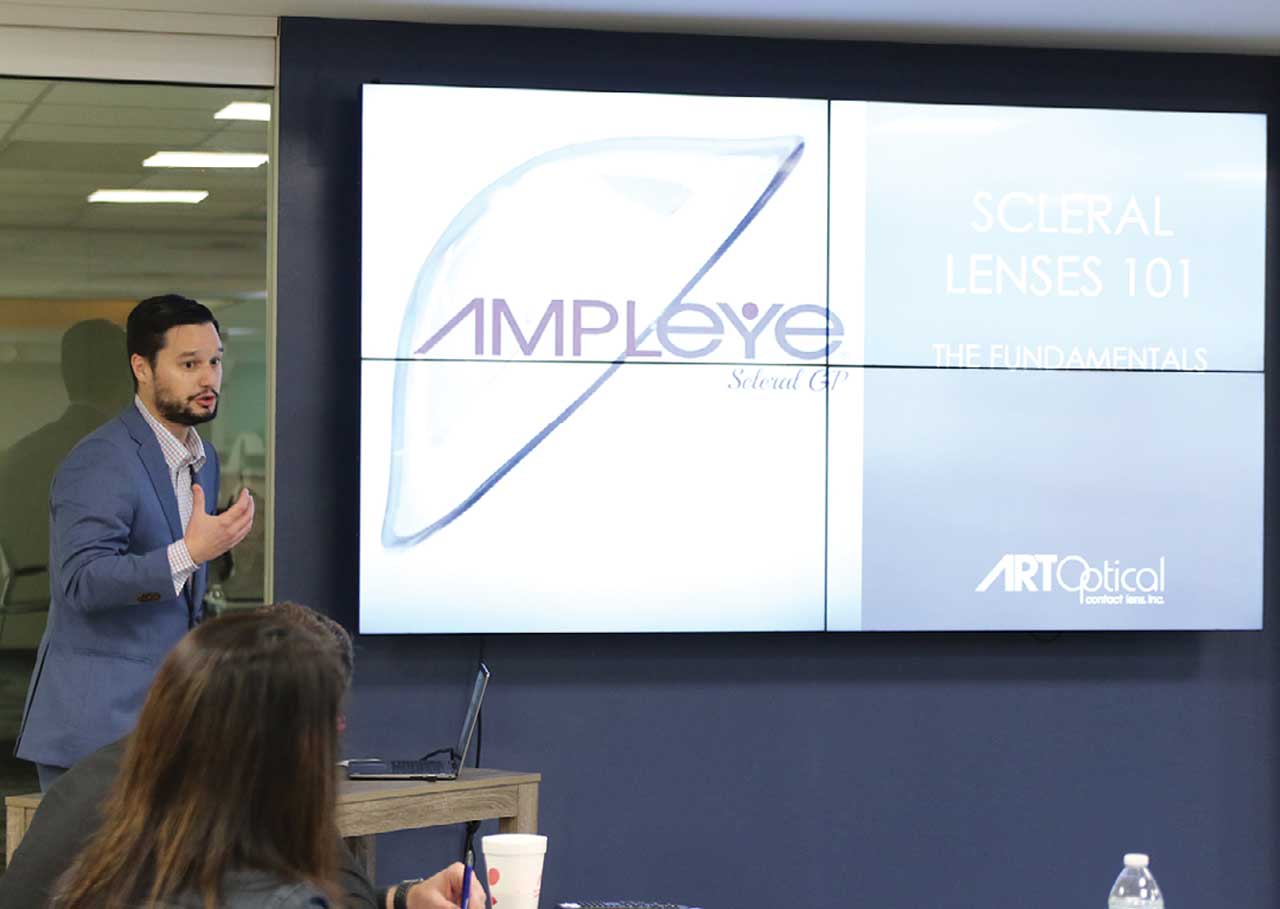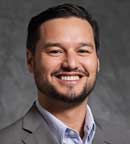Each time a practice considers bringing a new eyecare professional into the practice, it’s important to consider the new revenue streams that said ECP can introduce into the practice. When Dr. Davidson was interviewing to join the Williamson Eye Center, it became apparent that his passion for both scleral lenses and dry eye treatment would afford our nearly 80-year-old practice specializing in cataract and refractive surgery the opportunity for new areas of synergistic growth.
For the uninitiated, scleral lenses are large rigid-surface contact lenses custom-designed and computer-lathed for each patient. These lenses are designed to vault over the entire corneal surface and rest on the sclera. By doing so, scleral lenses can take an irregular cornea and, using the lens, essentially create a smooth optical surface to help correct vision problems caused by keratoconus, pellucid marginal degeneration, corneal ectasias and even corneal scarring. Not only this, but the “bowl” of the lens is filled with saline, and when worn, this fluid-filled space between the patient’s cornea and the back surface of the scleral lens acts as a fluid reservoir, allowing a constant amount of hydration for the cornea. Thus, patients with severe ocular surface disease can find relief when no other treatments have helped. Most often, these patients have no surgical options available to improve their vision, and typical refractive options such as spectacle and soft contact lenses do not give them their desired visual outcome.
For these reasons, fitting scleral lenses is often one of the most professionally fulfilling services we can provide. We get to tell patients that there is an option for them that will likely yield surprisingly sharp vision with a contact lens that is oftentimes more comfortable than most “soft” lenses.
In our practice in particular, patients come from as far as two states away as Dr. Davidson is the only “Fellow of the Scleral Lens Education Society,” or FSLS, in our area.
Here, we provide the benefits of adding a scleral lens division to your practice and tips for how to do.
BENEFITS
An increased revenue stream is the most obvious benefit. Many of our patients must pay cash for these lenses, and very few medical insurance companies will pay for the fitting procedure and the lenses themselves. For those with vision insurance, scleral lenses can be billed under “medically necessary contact lenses” when no other option works successfully for the patient (namely eyeglasses or soft contact lenses). The payment for these lenses can oftentimes be quite lucrative for the practice with a practitioner who is competent at fitting the lenses. And, if patients are coming from a wide region, it brings patients into the practice who would have never come otherwise.
Although the costs of the lenses and fitting vary wildly, we essentially see thousands of dollars of income from each patient every 1-2 years. After that first year/initial fitting, our scleral lens patients typically only require one or two visits every year thereafter. That is when a scleral lens clinic “ripens” and offers the practice substantial recurrent revenue, oftentimes in cash (for more on the fitting process, see below).
Another benefit comes with the regular purchasing of the products necessary to maintain and successfully wear these specialized lenses. Through an affiliation with www.dryeyerescuepro.com, our practice obtains and sells the saline used to fill the lenses each morning, the cleaning products used each night by the patient, the insertion and removal tools, and artificial tears we specifically recommend to be used over the lenses. We also direct our patients to their website, where they can use our coupon code, which brings us some of the revenue from their online purchases and subscription service signups.
Beyond the recurrent revenue from the lenses and products themselves, keep in mind that scleral lenses are oftentimes the first of multiple visits for these patients. Most of our scleral lens patients have some form of corneal ectasias like keratoconus or post-LASIK ectasia and are prime benefactors of corneal cross-linking (CXL).
After multiple discussions with our team, it was decided that CXL would be a synergistic addition to our practice’s surgical options. With the assistance of Glaukos, we introduced this option to our keratoconus patients who had already been referred for scleral lenses. While it is abundantly clear to our local optometrists when their patient needs a scleral lens, many of them are unaware when a patient is eligible for CXL and whether they should refer that patient.
With our clinic’s addition of CXL, we have become the “go-to” place for patients with abnormal corneas. When a patient is referred to us, we will discuss whether it would be appropriate to do CXL or to proceed with a scleral lens and return to CXL later. By performing CXL on our patients and then fitting them in scleral lenses, we are not only practicing sound medicine but also giving the absolute best care to our patients who may have believed there were no options available to them.
FITTING PROCESS AND CONSIDERATIONS
Due to the lenses’ inherent complexity and the diseased corneas found underneath the lenses, the fitting process can be quite daunting for patients and practitioners alike. A first-time scleral lens patient at our practice can expect to be seen anywhere from three to five times during their first year and initial fitting process.

Although this sounds daunting and potentially a drain on “chair cost” during that first year, remember that these lenses are typically reordered/refit every 1-3 years, depending on the patient, their insurance or other options. Our patients tend to return yearly if their insurance pays for their lenses and every 18 months if they pay cash. That first year, the practice can plan on at least three “fitting visits.” Each visit takes approximately 45 minutes to 1 hour of chair time and involves the placing of a trial lens on the patient’s eye, about 15 minutes of time for the lens to settle, OCT/topography/autorefractor readings over the lens, evaluation of the lens behind the slit lamp, as well as the subjective refraction over the lenses. After that, an experienced scleral lens fitter can order that initial lens in under 5 minutes through a lab’s online ordering system.
Each subsequent visit involves the placing of the newly ordered lens on the patient’s eyes, and all testing runs again. Any adjustments are made to a completely new lens that is created by the lab. When that lens arrives, yet another visit is done with the patient being forced to “swap” out their old lenses for the new one as no scleral lens laboratory allows the patient to keep more than one pair. In our office, Dr. Davidson averages one to two remakes for a first-time wearer to achieve the best possible outcome.
Much like all practitioners in all specialties, each scleral lens fitter requires a different number of staff members. Best practice, in our opinion, is at least one technician who can run all imaging necessary for the lenses, a scribe to enter the rooms with the doctor to write down all findings (this staff member also checks all lenses into and out of the clinic), a member of the billing/coding team who “takes ownership” of the specialty lens coding, and a cross-trained optician in the optical who can teach the patient insertion/removal techniques.
HOW TO GET STARTED
The first (and most important) thing is to find a practitioner who has the interest and drive to get it off the ground. Reach out to optometry schools and local optometric societies to see if anyone is interested in scleral lenses or knows someone who would like to help create this new division in your practice.
Then, the protocols must be developed, billing and coding baselines established, and equipment purchased. The equipment necessary is actually relatively minimal. All a good scleral lens fitter truly “needs” is a fitting set of their lens of choice and a good slit lamp. Most new scleral lens clinics can expect to pay between $400-$1000 for their first “fitting set” of scleral lenses.
Beyond that, an OCT with an anterior segment option is one of the most beneficial pieces of equipment that can be purchased for the practice. This will allow the ECP who is fitting the lenses to assess the central vault of the lens over the apex of the cone while also gaining a glimpse of the lens edges interacting with the conjunctiva.
As one would expect, a topographer is also desirable to ascertain just how steep the cornea is, which will allow the ECP a more educated starting point. As many patients requiring scleral lenses are also afflicted with corneal ectasias, a Pentacam (Oculus) would afford the clinic the ability to monitor the disease process more thoroughly. Oculus offers an extra software package, CSP (Cornea Scleral Profile). This CSP report measures the sagittal heights of the cornea and sclera.
Other upgrades that could be added as the clinic grows include a more advanced surface profiler, a device that allows the practitioner the ability to create freeform lenses that can vault over even the most abnormal ocular surface — and bringing in a price point that warrants the investment — as well as systems that allow higher order aberrations to be corrected even more accurately.
CONCLUSION
Scleral lenses change lives. It’s as simple as that. They also change your clinic. Seeing patients cry tears of joy after various refractive procedures is one of the highlights of our day. The tears from a patient who just received their first pair of scleral lenses and who firmly believed (and may have been told) that they had no option but to suffer from blurred vision hits a little bit differently. These patients are lifelong advocates for your clinic and are happy to return regularly to provide your business with recurrent revenue.
The downstream economic benefits from scleral lenses will surely provide any practice’s bottom line an added boost. Not only that, but you will also be able to keep these patients in your clinic. Patients with keratoconus are typically known as having terrible vision in the family and social circles. When you help them achieve a vision they never thought possible, you can’t put a price on that type of marketing.
Scleral lenses are truly a win-win for both your practice and your patients! OM










